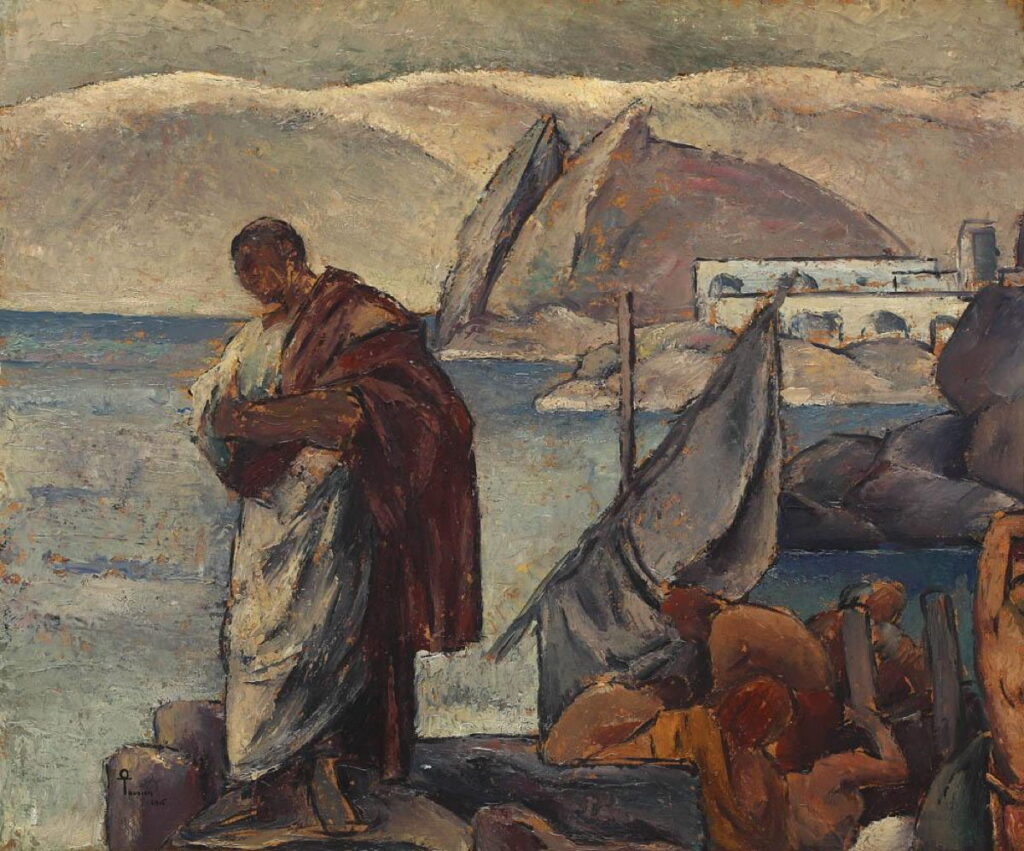Changing Paintings: an introduction to a new series on Ovid’s Metamorphoses

If you had walked into the workshop or studio of almost any European painter between 1500 and 1850, there’s one book you’d most likely find there: a well-worn copy of Ovid’s Metamorphoses. Of all the non-religious texts it has been the most influential literary work on Western painting. This article launches a new series here that works through all fifteen books in the Metamorphoses, telling the stories and showing the visual art that depicts them.
Ovid was a classical Roman poet, known in full as Publius Ovidius Naso. His first name (praenomen) was Publius, one of only about eighteen different first names available at that time, and usually pre-determined by birth order or other circumstances. Ovidius was the equivalent of his surname (nomen), indicating his family or clan. His family were soldier-farmers who owned quite large estates in the valleys around Sulmo (the modern town of Sulmona), in the Apennines to the east of Rome, where Ovid was born. As such, they were not properly Romans, but had aligned themselves with the Roman state and as a result had been assimilated into its social order and institutions. Naso was his nickname (cognomen), meaning nose, acquired by his family in the past, and indicated that one of his ancestors had a prominent nose.
Coming from the lesser country aristocracy, he received a good education, and his father expected him to aim for a career in law and probably politics. But these were turbulent times: Ovid was born in 43 BCE, the year following the assassination of Julius Caesar, the end of the Republic, and the start of civil wars leading to the new political order of Augustus, the Roman Emperor who ruled from 27 BCE until 14 CE.
Ovid was sent to Rome, where he was educated mainly in rhetoric, and started in some public posts at the foot of the ladder leading to his expected career. However, when he was only eighteen, he entered literary and poetic circles, and gave his first public recitation. He travelled to Greece, Asia Minor, and Sicily, and soon renounced a legal career to become a poet, against his father’s wishes.
Over the next twenty-five years or so, Ovid wrote some of the most important literary works of the time, after those of Virgil who died in 19 BCE. These explored love and human relationships (Heroides, Amores, and Ars Amatoria), and myth (Metamorphoses and Fasti), all of them written in verse.
Apart from Metamorphoses, which was written in hexameter, Ovid wrote primarily in elegiac meter. His poetry was thus intended principally for recitation and reading out loud, when its rhythms and poetic language would be most apparent and appreciated. Although this was over a millennium before the invention of printing, Ovid’s works were very popular, and copies were sold to many individuals and entered collections in Roman libraries.
Nicolas Poussin (1594–1665), The Triumph of Ovid (c 1624-25), oil on canvas, 148 x 176 cm, Galleria Nazionale d’Arte Antica, Rome. Wikimedia Commons.
Nicolas Poussin, who painted a large number of works telling stories from Metamorphoses, paid his tribute to the poet in The Triumph of Ovid in about 1624-25. Surrounded by Cupids and amorini, Ovid leans against books of his works, and holds high the laurel of achievement. At the right, a woman is asleep, one infant suckling at her breast. I’m unsure whether she is intended to represent one of Ovid’s three wives, or a character from his myths.
Ovid’s poetry was in many respects quite radical. Interpretations of his Metamorphoses remain controversial: superficially it appears to praise the Emperor Augustus, but there are signs of deeper critical intent. Ovid’s love poetry was, though, a more flagrant challenge to the rule of Augustus, who had established adultery as both a private and public crime in 18-17 BCE. Any encouragement of relationships beyond the confines of marriage was thus an obvious target.
In 8 BCE, Augustus suddenly banished Ovid to the far north-east of the Roman empire. The only account of this is Ovid’s, in which he gives two reasons: one was his (love) poetry, the other what Ovid refers to as a ‘mistake’, but doesn’t detail. Despite extensive and imaginative speculation, no one knows what ‘mistake’ might have offended the emperor so deeply.
Joseph Mallord William Turner (1775–1851), Ancient Italy – Ovid Banished from Rome (1838), oil on canvas, 94.6 x 125 cm, Private collection. Wikimedia Commons.
JMW Turner’s magnificent painting Ancient Italy – Ovid Banished from Rome exhibited in 1838 is strongly reminiscent of Claude Lorrain’s contre-jour dusk riverscapes, and gives a thoroughly romantic view of departure by boat from the bank of the Tiber. Turner may not be as well known now for his paintings of Ovidian myths, but at the time they had formed a central part of his work.
Ovid travelled by boat and overland until he reached the eastern coast of the Black Sea at what was then Tomis, now the Romanian holiday resort of Constanța. By this time, Tomis was a well-established city that had developed over a period of more than five hundred years. The area had been annexed by the Romans in 29 BCE, and was still on the far frontier of the empire: travel a little further north along the coast and you would have reached Roman forces defending territory against hostile tribes.
The local Scythians seemed more content with their place in the empire, and Ovid appears to have been among friends, just not those of his choosing. His third wife remained back in Rome, and Ovid had to live in a largely non-Latin-speaking society with no access to libraries.
His predicament was a lasting inspiration to Eugène Delacroix, who first started to develop paintings of it around 1835. His first known painting showing Ovid in exile was completed in 1844, for the ceiling of the Library of the Palais Bourbon in Paris.
Eugène Delacroix (1798–1863), Ovid among the Scythians (1859), oil on canvas, 87.6 x 130.2 cm, The National Gallery (Bought, 1956), London. Image courtesy of and © 2017 The National Gallery.
In 1859, as he neared the end of his career, Delacroix painted Ovid among the Scythians. He shows Tomis as a rural and primitive area on a narrow coastal plain amid rugged, hilly country. The Scythians follow their legendary reputation of living on mare’s milk, as demonstrated by the barebacked local milking a mare in the right foreground.
Eugène Delacroix (1798–1863), Ovid among the Scythians (1862), oil on paper mounted on wood, 32.1 × 50.2 cm, The Metropolitan Museum of Art, New York, NY. Wikimedia Commons.
Just a year before his death in 1863, Delacroix tried again with this variation of Ovid among the Scythians, which alters the composition and enlarges the figures. Although wonderfully painterly and rich in colour, it remains romantic and embroiders the myth that Ovid had started to create in his writings from exile.
Ion Theodorescu-Sion (1882–1939), Ovid in Exile (1915), oil on cardboard, 36.5 x 43.5 cm, location not known. Wikimedia Commons.
The Romanian artist Ion Theodorescu-Sion’s version of Ovid in Exile (1915) appears more realistic, showing Tomis with more substantial buildings and a port.
Deprived of a library, Ovid was unable to complete his detailed account of the Roman calendar started in his Fasti, but he did continue writing. His Tristia and Epistulae ex Ponto from those years in Tomis provide the only real information we have about his life. He died there in 17 or 18 CE, his many appeals to the emperor for clemency unheeded.
Johann Heinrich Schönfeld (1609–1684), Scythians at the Tomb of Ovid (c 1640), oil, dimensions not known, Szépművészeti Múzeum, Budapest, Hungary. Wikimedia Commons.
Johann Heinrich Schönfeld’s Scythians at the Tomb of Ovid (c 1640) shows an imaginary scene of local Scythians paying homage to Ovid’s tomb. Unlike Delacroix’s depictions of them as friendly barbarians, I suspect Schönfeld comes closer to the truth.
Next week, the first episode of this new series looks at Roman creation myths, the fall of the Titans (gigantomachy), and the cannibalism of Lycaon. I hope you’ll join me.
References
Boyd, Barbara W (ed) (2002) Brill’s Companion to Ovid, Brill. ISBN 978 90 04 22676 0.
Hardie, Philip (2002) The Cambridge Companion to Ovid, Cambridge UP. ISBN 978 0 521 77528 1.
Knox, Peter E (ed) (2009, 2013) A Companion to Ovid, Wiley-Blackwell. ISBN 978 1 118 45134 2.
Middlebrook, Diane (2014) Young Ovid, an Unfinished Biography, Counterpoint. ISBN 978 1 61902 331 4.




